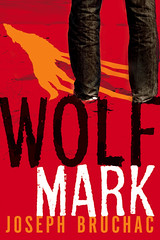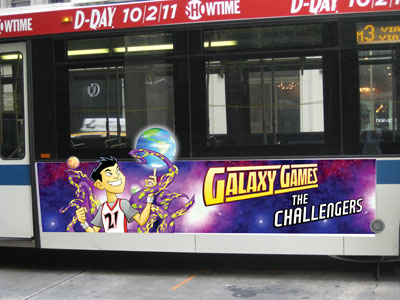Hey, remember how I published three books this fall? If you’re looking for great reads for the science fiction or fantasy buff in your life, you should remember Tu’s go some great books! Here are some links for you in case you need them, or go down to your local bookseller. If they don’t have the books in stock (B&N has Tankborn and Wolf Mark, but sometimes an indie might not), ask them to order them in! The more a book gets bought in a local indie, for example, the more they take notice and think maybe it should be on their shelves.
Galaxy Games: The Challengers by Greg Fishbone
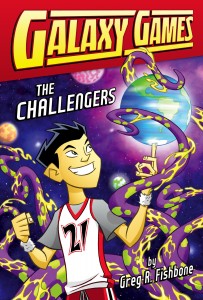
Indiebound: Find a copy at your local independent bookstore! Google e-book
B&N: Hardcover and E-book
Ipad & Iphone: E-book
Things are looking up for Tyler Sato (literally!) as he and his friends scan the night sky for a star named for him by his Tokyo cousins in honor of his eleventh birthday. Ordinary stars tend to stay in one place, but Ty’s seems to be streaking directly toward Earth at an alarming rate. Soon the whole world is talking about TY SATO, the doomsday asteroid, and life is turned upside down for Ty Sato, the boy, who would rather be playing hoops in his best friend’s driveway.
Meanwhile, aboard a silver spaceship heading for Earth, M’Frozza, a girl with three eyes and five nose holes, is on a secret mission. M’Frozza is the captain of planet Mrendaria’s Galaxy Games team, and she is desperate to save her world from a dishonorable performance in the biggest sporting event in the universe.
What will happen when Ty meets M’Frozza? Get ready for the most important event in human history—it’ll be off the backboard, around the rim, and out of this world!
Tankborn by Karen Sandler
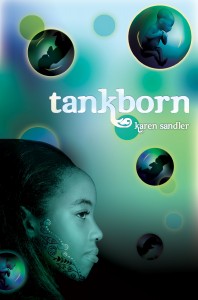 Indiebound: Find a copy at your local independent bookstore! Google e-book
Indiebound: Find a copy at your local independent bookstore! Google e-book
B&N: Hardcover and E-book
Ipad & Iphone: E-book
Best friends Kayla and Mishalla know they will be separated when the time comes for their Assignments. They are GENs, Genetically Engineered Non-humans, and in their strict caste system, GENs are at the bottom rung of society. High-status trueborns and working-class lowborns, born naturally of a mother, are free to choose their own lives. But GENs are gestated in a tank, sequestered in slums, and sent to work as slaves as soon as they reach age fifteen.
When Kayla is Assigned to care for Zul Manel, the patriarch of a trueborn family, she finds a host of secrets and surprises—not least of which is her unexpected friendship with Zul’s great-grandson. Meanwhile, the children that Mishalla is Assigned to care for are being stolen in the middle of the night. With the help of an intriguing lowborn boy, Mishalla begins to suspect that something horrible is happening to them.
After weeks of toiling in their Assignments, mystifying circumstances enable Kayla and Mishalla to reunite. Together they hatch a plan with their new friends to save the children who are disappearing. Yet can GENs really trust humans? Both girls must put their lives and hearts at risk to crack open a sinister conspiracy, one that may reveal secrets no one is ready to face.
Wolf Mark by Joseph Bruchac
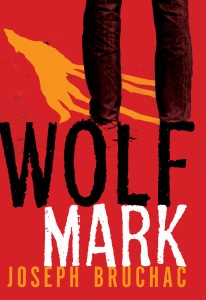 Indiebound: Find a copy at your local independent bookstore! Google e-book
Indiebound: Find a copy at your local independent bookstore! Google e-book
Amazon: Hardcover E-book
B&N: Hardcover and E-book
Ipad & Iphone: E-book
Luke King knows a lot of things. Like four different ways to disarm an enemy before the attacker can take a breath. Like every detail of every book he’s ever read. And Luke knows enough—just enough—about what his father does as a black ops infiltrator to know which questions not to ask. Like why does his family move around so much?
Luke just hopes that this time his family is settled for a while. He’ll finally be able to have a normal life. He’ll be able to ask the girl he likes to take a ride with him on his motorcycle. He’ll hang out with his friends. He’ll be invisible—just as he wants.
But when his dad goes missing, Luke realizes that life will always be different for him. Suddenly he must avoid the kidnappers looking to use him as leverage against his father, while at the same time evading the attention of the school’s mysterious elite clique of Russian hipsters, who seem much too interested in Luke’s own personal secret. Faced with multiple challenges and his emerging paranormal identity, Luke must decide who to trust as he creates his own destiny.
And just a reminder that in the spring we’ll have two more great books for you to check out!
Cat Girl’s Day Off by Kimberly Pauley
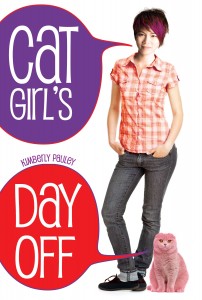 Never listen to a cat. That will only get you in trouble.
Never listen to a cat. That will only get you in trouble.
Actually, scratch that. Listening to cats is one thing, but really I should never listen to my best friend Oscar. It’s completely his fault (okay, and my aspiring actress friend Melly’s too) that I got caught up in this crazy celebrity-kidnapping mess.
If you had asked me, I would have thought it would be one of my super-Talented sisters who’d get caught up in crime fighting. I definitely never thought it would be me and my Talent trying to save the day. Usually, all you get out of conversations with cats is requests for tummy rubs and tuna.
Wait . . . I go back to what I said first: Never listen to a cat. Because when the trouble starts and the kitty litter hits the fan, trust me, you don’t want to be in the middle of it.
Vodnik by Bryce Moore
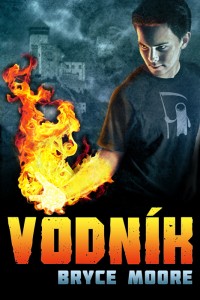 Teacups: great for tea. Really sucky as places-to-live-out-the-rest-of-your-eternal-existence. Very little elbow room, and the internet connection is notoriously slow. Plus, they’re a real pain in the butt to get out of, especially when you’ve gone non-corporeal.
Teacups: great for tea. Really sucky as places-to-live-out-the-rest-of-your-eternal-existence. Very little elbow room, and the internet connection is notoriously slow. Plus, they’re a real pain in the butt to get out of, especially when you’ve gone non-corporeal.
When Tomas was six, someone—something—tried to drown him. And burn him to a crisp. Tomas survived, but whatever was trying to kill him freaked out his parents enough to convince them to move from Slovakia to the United States.
Now sixteen-year-old Tomas and his family are back in Slovakia, and that something still lurks somewhere. Nearby. Ready to drown him again and imprison his soul in a teacup.
Then there’s the fire víla, the water ghost, the pitchfork-happy city folk, and Death herself who are all after him.
All this sounds a bit comical, unless the one haunted by water ghosts and fire vílas or doing time in a cramped, internet-deprived teacup is you.
If Tomas wants to survive, he’ll have to embrace the meaning behind the Slovak proverb, So smrťou ešte nik zmluvu neurobil. With Death, nobody makes a pact.

 Who’s going to
Who’s going to 
